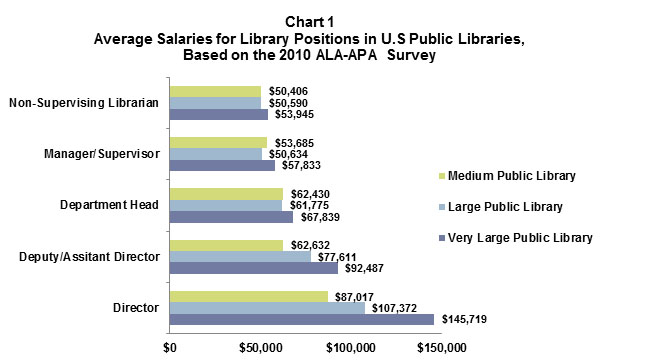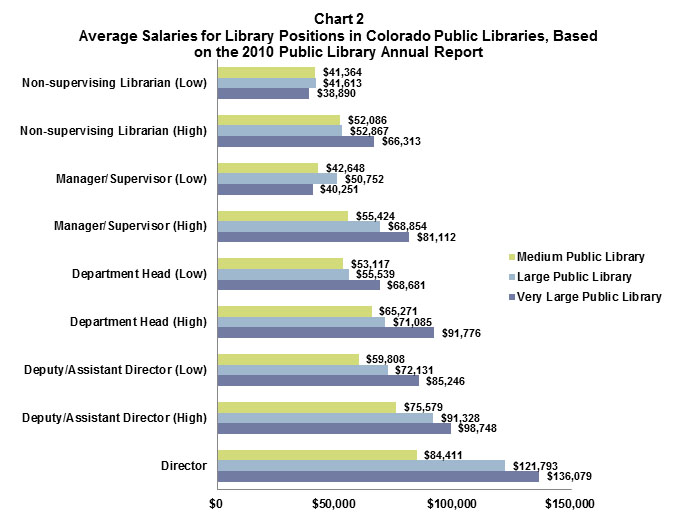The 2010 Public Library Annual Report (PLAR) produced by the Library Research Service and the 2010 ALA-APA Salary Survey published by the American Library Association-Allied Professional Association both provide windows into the compensation earned by library professionals. Both the PLAR and the ALA-APA Salary Survey collect and publish salary data about similar library positions (see below), and classify libraries by size according to the same guidelines.[note]Both the ALA-APA Salary Survey and the PLAR classify public libraries by population size: very small (less than 10,000), small (10,000 to 25,000), medium (25,000-99,999), large (100,000-499,999), and very large (500,000 or more). Very small and small libraries were not included in this analysis because job duties and descriptions in smaller libraries tend to vary widely, are less specialized, and are therefore more difficult to compare. In addition, the data set for the very small and small libraries is incomplete with far fewer cases.[/note] Yet, the 2 reports vary significantly in other respects. The ALA-APA Salary Survey draws data from a sample of libraries nationally, and reports this information at the national, regional, and state levels, whereas the PLAR takes its data from a census of Colorado public libraries. Despite these differences, looking at the 2 reports side-by-side yields insights about the spectrum of salaries for public library professionals in Colorado and nationally.
The 2010 ALA-APA Salary Survey
Comparing national data averages, librarians in medium and large libraries make less than librarians in very large libraries, but the difference is fairly small for non-supervising librarians, managers/supervisors, and department heads (see Chart 1). There is a difference of less than 15 percent between the medium and very large libraries within these job categories. For example, managers/supervisors in very large libraries make 8 percent more than managers in medium libraries. However, for assistant directors and directors the variance is much greater, with directors making two-thirds more in very large public libraries than in medium libraries (68%).
• Non-Supervising Librarians: Librarians who do not supervise.
• Manager/Supervisor: Individuals who supervise staff in any part of the library but do not supervise librarians with MLS degrees.
• Department Heads, Coordinators, Senior Managers: Individuals who supervise one or more librarians with MLS degrees.
• Associate Directors: Individuals who report to the Director and manage major aspects of the library operation.
• Directors: Chief Officers of libraries or library systems.

The 2010 Colorado Public Library Annual Report (PLAR)
Unlike the ALA-APA survey, the PLAR gathers the high and low salaries for non-supervising librarians, managers/supervisors, department heads, and associate directors from all public libraries in Colorado, with 3 very large, 9 large, and 14 medium public libraries reporting data. (Note that directors’ salaries are represented by only 1 figure per library, not a range.)
Several patterns emerge from this data (see Chart 2). For one, the differences between low and high salaries, across all positions, are more drastic in very large public libraries than in medium and large public libraries. For example, in medium public libraries, high-end salaries for managers/supervisors are 30 percent higher than low-end salaries, and in large public libraries, high-end salaries for managers/supervisors are 36 percent more than low-end salaries, whereas in very large public libraries, this difference is the most extreme, with managers/supervisors at the high-end of the scale earning more than twice as much as non-supervising librarians.
Comparing professional salaries in medium, large, and very large public libraries across Colorado, pay rates in very large libraries generally trump those in medium and large libraries. Yet, this trend is not true of low-end salaries for librarians and managers/supervisors, who tend to earn more in medium and large public libraries than in very large public libraries.
Conclusion
Despite obvious differences between the PLAR and ALA-APA Salary survey data, some comparisons between the two are inevitable. These show that, on average, directors in Colorado tend to make less than directors nationally. Salaries for other library positions in Colorado are more evenly matched to the national averages, with the mean salaries for the nation generally falling between the average high and low salaries in Colorado. The 2010 PLAR and ALA-APA Salary Survey data also show that in Colorado and across the nation, library professionals in very large and large public libraries tend to earn more than their peers in medium public libraries.
